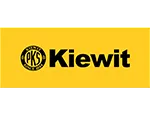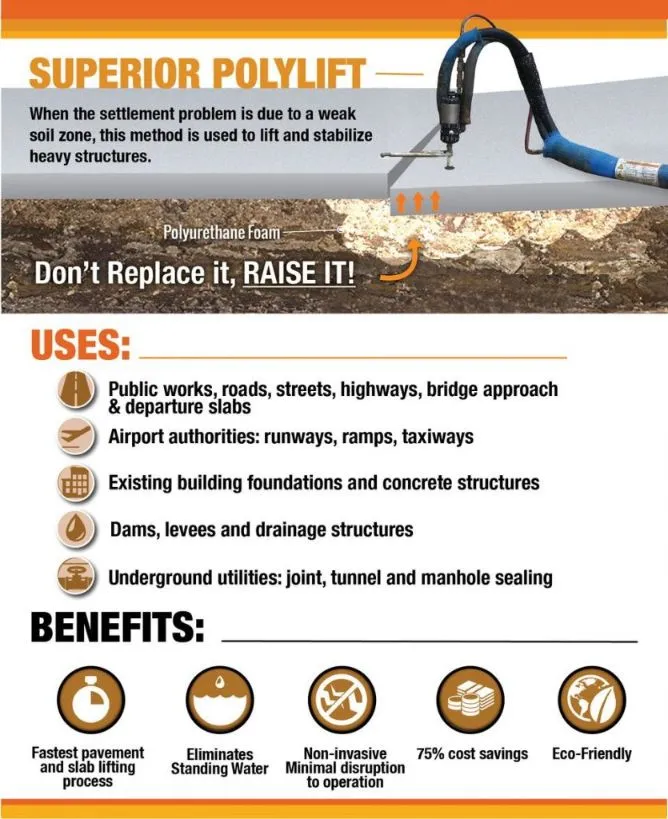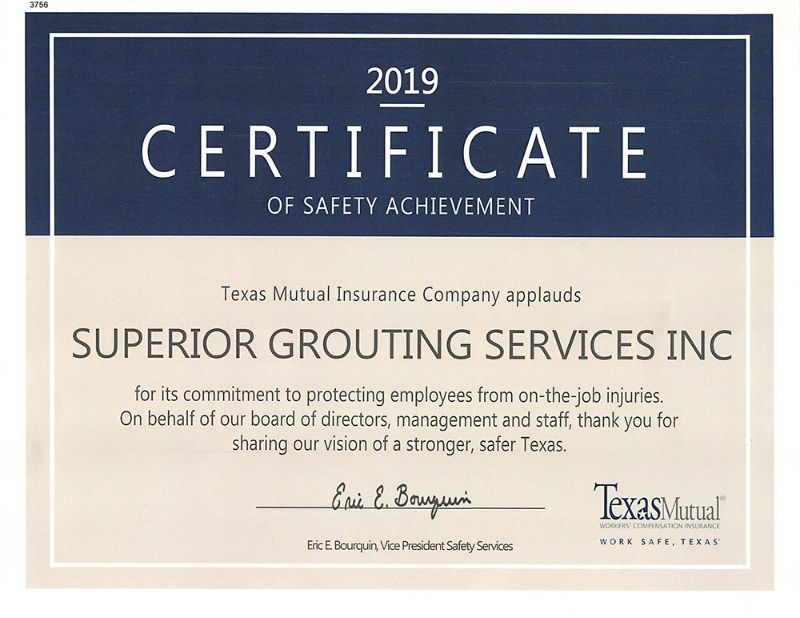Polyurethane grouting
Polyurethane grouting is a cleaner, faster and less disruptive than cement grouting. From commercial floors to interstates, and everything in between, polyurethane grouting is
economical, fast and effective
for
correcting settlement and instability
.
Two polyurethane liquid components are mixed and injected (hence also being called
polyurethane injection
) under pressure below the area or structure being repaired. The two liquids react with each other, expand and harden, like the foam grouting you get in a can to seal around windows. Our poly blend grout stay a liquid for a few seconds before expanding. This helps them spread out from the exact spot they’re injected, but then get harder much faster, and can exert much more force during expansion.
Polyurethane foam concrete lifting
excels compared to cement-based grouting primarily due to cleanliness, speed and control. These combine to reduce overall costs compared to cement-based grouting. Polyurethane foundation repair can be used in place of
cement-based grouts
for processes such as
compaction grouting,
slab jacking
,
void filling and leak sealing
. Polyurethane grouting is…
-
Cleaner -
Polyurethane foam concrete
is the cleanest concrete lifting foam and stabilization process. Because the injection equipment is mechanically connected to the slab or structure, and mechanical seals engage when not injecting material, no loose material is introduced to the repair area. Extruded material is easy to clean up because it cures very quickly. -
Less Disruptive -
Polyurethane foam foundation repair
is the quietest and fastest process for stabilizing and raising settled poly jack concrete slabs. Because of the small hole size, drilling is fast and quiet, and there is virtually no noise associated with the injection process itself. The equipment for poly grouting is self-contained in a box truck or enclosed trailer, which can be parked up to 210 feet away from the injection point. - Immediate Traffic - Foot traffic during work is functionally OK, and immediate resumption of vehicular traffic after work is completed can be expected. Polyurethane foam injection concrete lifting is not affected by foot traffic during the poly injection process. Vehicular traffic may resume immediately after work is completed. This includes heavy loading such as trucks and industrial equipment like forklifts, and even trains.
- Fast - Polyurethane grout injection crews can lift up to 12 times faster than standard slab jacking or mud jacking crews in many situations. Because of the small hole size and ability to lift larger areas per hole, Pu grouting is much quicker than poly slab jacking. Because of the equipment design, upon arriving on a job, polyurethane grout crews are typically actively lifting slabs within 10 minutes of arrival for typical repairs.
- Lightweight - Lightweight material reduces the overburden on underlying soils, reducing the chances for resettlement. Even the highest density polyurethane foam injection used for poly grout are significantly lighter than alternative lifting and stabilization materials. This reduces the amount of additional burden weight placed on the underlying soils. Geotechnical polyurethanes are an excellent choice for lightweight fills, because of their exceptionally low unit weights (down to 2 PCF) and fast cure times (few minutes).
- Waterproof - High density polyurethane is waterproof, so treated slabs are thoroughly undersealed. Polyurethane can also be installed in water, so flow testing or water stop applications with active flows are not a problem. Because of the near-immediate curing, water stopping jobs are fast and easily tested on site to ensure efficacy of the repairs.
What POLYURETHANE INJECTION Is Best For
There are many times when polyurethane grouting is the only repair process that will address a problem. Here are some of the times when polyurethane grouting is best:
- Large Slabs
Large slabs (typically bigger than 100 square feet) are best repaired with
foam concrete repair
because polyurethane can travel under the entire slab from just one or two injection holes. This creates a more diffuse lifting force than cementitious grout. This speeds up work and lessens the chance of cracking.
Faster reacting lower density foams typically start to expand within a few seconds of injection, so they are good for
concrete slab foam jacking. Slower reacting, higher density foams can travel as a liquid for up to 45 seconds before starting to expand and harden. This allows them to lift extremely large areas, as the liquid is injected at 1100 psi, which forces it into what can be very small spaces under the
foam concrete slab
.
- Heavy Slabs
- Because of its high expansion force and ability to spread under large areas of slabs and structures before expanding, high density polyurethane can lift extremely heavy slabs with ease. These include roadway slabs, bridge approaches, rail crossings and slabs with heavy loads, such as machinery bases and floors with backup battery power packs.
- Areas Where Cleanliness is Important
- Due to the small, infrequent holes, dustless drilling is easy. Additionally, because there is a mechanical connection between the injection equipment and the slab, no material is exposed to the surface or surroundings. Automatic, mechanical valves on the injection equipment prevent leakage of material when not injecting. We use special dustless drilling equipment for most interior jobs.
- Load Sensitive Areas
- The most common cause of slab settlement is inadequate compaction or bearing capacity of the underlying soils. Because high density polyurethane is lightweight (typically 2.5 to 6 pounds per cubic foot), there is very little additional weight transferred to the underlying soil as part of repairs. This helps to minimize the chances of resettlement. Sand-based and concrete foam jacking used for slab jacking or pressure grouting typically weigh more than 100 pounds per cubic foot. The weight savings with polyurethane grouting are significant.
- Remote Sites
Because high density polyurethane is stored and transported as a liquid which then expands. A single non-CDL box truck can easily transport more than 100 cubic yards of expanded material. The equivalent for slab jacking grout would require more than 6 large dump truck loads and onsite handling equipment. Raw polyurethane material is transported in standard chemical totes. So is easily transported, stored and handled on job sites.
- Airport, railroad, and infrastructure repairs
- Industrial commercial buildings
- Municipal infrastructure repairs
- Pipeline trench breakers
- Bridge approach and departure slabs
- Warehouse and office floors
- Distribution center parking lots and drives
Superior Grouting Services
Superior Grouting’s team of experts has decades of experience in specialty grouting projects and concrete remediation.
Our Accomplishments






































